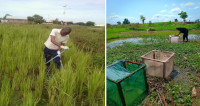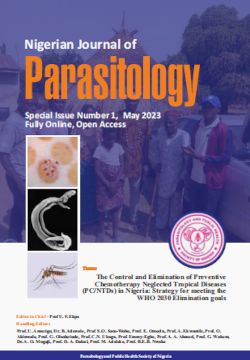Relative Productivity of Mosquito Larval Habitats for Abundance and Immature stages Distribution in Relation to Physicochemical Properties in Niger State, Nigeria
https://dx.doi.org/10.4314/njpar.v44i1.16
Keywords:
Niger State, productivity, physico-chemical properties, Immature mosquitoesAbstract
Immature mosquitoes were evaluated for the productivity of the breeding habitats using field cages in Niger State. Mosquitoes were sampled weekly both outside and inside field experimental cages by dipping and emptying the cages in a bowl container and identified using microscope-guided standard morphological keys. Three genera namely, Aedes, Anopheles, and Culex, were encountered and the mean immature abundance rate (IAR), in gutters, follows decreasing order and dominated by Culex (93.16±10.79%) > Anopheles (17.79±2.23%) > Aedes (15.77±2.12 %). In swamps, Anopheles highest mean (78.04±8.00%), followed by Culex (28.13±2.55%) and Aedes (14.54±1.56%). Similarly, in large water bodies, the distribution decreases as; Anopheles (74.33±7.07%)> Culex (27.14±2.50%)>Aedes (12.91±1.30%). In terms of immature productivity rate (IPR) among the three genera, Culex had the highest mean in gutters (191.29±22.37%) followed by Anopheles in large waters and swamps (148.03±14.81% and 153.15±15.92%) while lowest was Aedes (25.57±2.42%) in large water. Furthermore, for the density of immature, 1st stage (L1) recorded the highest followed by 2nd stage (L2), followed by 3rd stage (L3), and the least was the 4th stage (L4) for IAR and IPR. For the estimation of breeding habitats, the cage sampling method is the most reliable (709.86±73.63 mosquitoes) when compared with dipping techniques that recorded 324.06±44.00 mosquitoes. Mosquito physicochemical conditions varied significantly with DO (8.83±0.40) in large water bodies; nitrate (4.57±0.55), phosphate (3.26±0.73), calcium (88.19±12.79), sulphur (28.23±2.45), potassium (10.63±0.76), chlorine (87.52±20.89) and alkalinity (187.00±26.39) in the gutters. However, a positive correlation between rainfall and mosquito species (r = 0.523 to 0.801) as well as between relative humidity and mosquitoes (r= 0.236 to 0.551, p>0.05) on mosquito populations. Only Anopheles in large water habitats was significant (0.801*, p>0.05). The findings revealed disparities in the abundance and larval habitat production rates of the mosquito genera and associated positively with some physicochemical and metrological cues. Consequently, an effective tactic must be developed for mosquito control, particularly in the most highly recognized breeding habitats.
References
Dida, G. O., Gelder, F. B., Anyona, D. N., Abuom, P. O., Onyuka, J. O., Matano, A.- S., and Ouma, C. (2015). Presence and distribution of mosquito larvae predators and factors influencing their abundance along the Mara River, Kenya and Tanzania. SpringerPlus, 4(1), 136.
Sofizadeh, A., Shoraka, H. R., Mesgarian, F., Ozbaki, G. M., Gharaninia, A., Sahneh, E., and Nemani, S. (2018). Fauna and larval habitats characteristics of mosquitoes (Diptera: Culicidae) in Golestan Province, Northeast of Iran, 2014–2015. Journal of Arthropod-Borne Diseases,
(3), 240-251
Ortega-Morales, A., Zavortink, T., Huerta-Jiménez, H., Ibáñez-Bernal, S., and Siller-Rodríguez, Q. (2019). The mosquitoes (Diptera: Culicidae) of Hidalgo State, Mexico. Acta tropica, (189), 94-103.
Makanda, M., Kemunto, G., Wamuyu, L., Bargul, J., Muema, J., and Mutunga, J. (2019). Diversity and molecular characterization of mosquitoes (Diptera:Culicidae) in selected ecological regions in Kenya. F1000 Research, 8.
Gooch, E. (2017). The impact of reduced incidence of malaria and other mosquitoborne diseases on global population. Journal of Development Economics, (124), 214-228.
Opara, K., Ekanem, M., Udoidung, N., Chikezie, F., Akro, G., Usip, L., and Igbe, M. (2017). Insecticide susceptibility profile of Anopheles gambiae sl from Ikot-Ekpene, Akwa Ibom State, Nigeria. Annual Research & Review in Biology, 1-9.
Afolabi, O. J., Akinneye, J. O., and Igiekhume, A. M. (2019). Identification, abundance, and diversity of mosquitoes in Akure South Local Government Area, Ondo State, Nigeria. The Journal of Basic and Applied Zoology, 80(1), 1-7.
Olayemi, I., Ukubuiwe, A., and OyiboUsman, K. (2014). Mosquito species occurrence and diversity in conventional larval breeding sites in Minna metropolis, Nigeria. International Journal of Innovation Science Research, 9(1), 86-93.
Barde, A. A., Omar, A. A., Panda, S. M., Hussaini, S., and Dalhatu, A. (2019). Studies on the composition and distribution of the different sibling species of Anopheles gambiae complex within Katagum area in Bauchi state, Nigeria. International Journal of Mosquito Research 6(3): 01-04.
Dowling, Z., Ladeau, S. L., Armbruster, P., Biehler, D., and Leisnham, P. T. (2013). Socioeconomic status affects mosquito (Diptera: Culicidae) larval habitat type availability and infestation level. Journal of Medical Entomology, 50(4), 764-772.
Medeiros-Sousa, A. R., de OliveiraChriste, R., Camargo, A. A., Scinachi, C. A., Milani, G. M., Urbinatti, P. R., Natal, D., Ceretti-Junior, W., and Marrelli, M. T. (2020). Influence of water's physical and chemical parameters on mosquito (Diptera: Culicidae) assemblages in larval habitats in
urban parks of São Paulo, Brazil. Acta t r o p i c a , 2 0 5 , 105394.https://doi.org/10.1016/j.actatropic a.2020.105394
Nagy, A., El-Zeiny, A., Elshaier, M., Sowilem, M., and Atwa, W. (2021). Water quality assessment of mosquito breeding water localities in the Nile Valley of Giza Governorate. Journal of Environmental Sciences, 50(1), 1-10.
Razali, S. M. (2022). Physicochemical characteristics and microbiological quality of silkworm (Bombyx mori) larval and pupae powder: a comparative study. Sains Malaysiana, 51(2), 547-558.
Musiime, A. K., Smith, D. L., Kilama, M., Geoffrey, O., Kyagamba, P., Rek, J., Conrad, M. D., Nankabirwa, J. I., Arinaitwe, E., Akol, A. M., Kamya, M. R., Dorsey, G., Staedke, S. G., Drakeley, C., and Lindsay, S. W. (2020). Identification and characterization of immature Anopheles and Culicines (Diptera: Culicidae) at three sites of varying malaria transmission intensities in Uganda. Malaria Journal, 19(1), 221. https://doi.org/10.1186/s12936-020-03304-7
Amini, M., Hanafi-Bojd, A. A., Aghapour, A. A., and Chavshin, A. R. (2020). Larval habitats and species diversity of mosquitoes (Diptera: Culicidae) in West Azerbaijan Province, Northwestern Iran. BMC Ecology, 20(1), 1-11.
Ibrahim, S. K. (2022). Species composition
and productivity of mosquitoes in relation to physico-chemical conditions, general reserves, insecticide susceptibility and community knowledge on mosquito borne diseases in Niger, Nigeria. PhD thesis, Universiti Sains Malaysia.
Ukubuiwe,A. C., Olayemi, I. K., Omalu, I. C. J., Arimoro, F. O., Baba, B. M., and Ukubuiwe, C. C. (2018). Influence of variable photoperiod on life-stages mobilization of teneral reserves in Culex quinquefasciatus (Diptera: Culicidae): implication for environmental manipulation for vector control. Molecular Entomology (9)1, 1-10.
Akpan, G., Adepoju, K., Oladosu, O., and Adelabu, S. (2018). Dominant malaria vector species in Nigeria: Modelling potential distribution of Anopheles gambiae sensu lato and its siblings with MaxEnt. PLoS One, 13(10).
Getachew, D., Balkew, M., and Tekie, H. (2020). Anopheles larval species composition and characterization of breeding habitats in two localities in the Ghibe River Basin, southwestern Ethiopia. Malaria Journal, 19(1), 1-13.
Shil, P., and Balasubramanian, R. (2020). Meteorological parameters and mosquito species diversity and abundance along the Arabian Sea Coastline of Alappuzha District, India: A Year-round Study. Journal of Mosquito Research, (18),10.
Azari-Hamidian, S. (2011). Larval habitat characteristics of the genus Anopheles (Diptera: Culicidae) and a checklist of mosquitoes in Guilan Province, northern Iran. Iranian Journal of Arthropod-Borne Diseases, 5(1): p. 37.
Wang, J. N., Hou, J., Zhong, J. Y., Cao, G. P., Yu, Z. Y., Wu, Y. Y., Li, T. Q., Liu, Q. M., and Gong, Z. Y. (2020). Relationships between traditional larval indices and meteorological factors with the adult density of Aedes albopictus captured by BGmosquito trap. PLoS ONE, 15(6), e0234555. https://doi.org/10.1371/journal.pone.02345 55
Wang, Y., Cheng, P., Jiao, B., Song, X., Wang, H., Wang, H., Wang, H., Huang, X., Liu, H., and Gong, M. (2020). Investigation of mosquito larval habitats and insecticide resistance in an area with a high incidence of mosquito-borne diseases in Jining, Shandong Province. PLoS ONE,
(3),e0229764. https://doi.org/10.1371/journal.pone.0229764
Snell, A. E. (2005). Identification keys to larval and adult female mosquitoes (Diptera: Culicidae) of New Zealand. New Zealand Journal of Zoology, 2005. 32(2): p. 99-110.
Siria, D. J., Sanou, R., Mitton, J., Mwanga, E. P., Niang, A., Sare, I., Johnson, P. C. D., Foster, G. M., Belem,A. M. G., Wynne, K., Murray-Smith, R.,
Ferguson, H. M., González-Jiménez, M., Babayan, S.A., Diabaté,A., Okumu, F. O., and Baldini, F. (2022). Rapid age-grading and species identification of natural mosquitoes for malaria surveillance. Nature Communications, 13(1),1501. https://doi.org/10.1038/s41467-022-28980-
Dalpadado, R., Amarasinghe, D., and Gunathilaka, N. (2022). Water quality characteristics of breeding habitats in relation to the density of Aedes aegypti and Aedes albopictus in domestic settings in Gampaha district of Sri Lanka. Acta Tropica, (229), 106339.
Nascimento, D. A. S., Trindade, F. T. T., and Silva, A. D. A. E. (2021). Dietary supplementation with vitamins and minerals improves larvae and adult rearing conditions of Anopheles darlingi (Diptera: Culicidae). Journal of Medical Entomology, 58(1), 71- 78.
Huck, D. T., Klein, M. S., and Mbuti, M. E. (2021). Determining the effects of nutrition on the reproductive physiology of male mosquitoes. Journal of Insect Physiology, (129), 104191.
Dom, N. C., Mokhtar, M. A. M., and Australia, C. T. (2019). Development and oviposition preferences of field collected Aedes albopictus based on different water characteristics. Malaysian Journal of Fundamental & Applied Sciences, (15), 61- 64.
Kibret, S., Wilson, G. G., Ryder, D., Tekie, H., and Petros, B. (2019). Environmental and meteorological factors linked to malaria transmission around large dams at three ecological settings in Ethiopia. Malaria Journal, 18(1), 1-16.
Madzlan, F., Dom, N. C., Zakaria, N., Hasnan, S. N. A., Tiong, C. S., and Camalxaman, S. N. (2018). Profiling of dengue vectors breeding habitat at urban residential areas in Shah Alam, Malaysia. Serangga, 22(2).
Chuntar, H. S., Kayode, O. I., James, O. I. C., Sherifat, A. F., Sunday, E. S., and Agha, O. C. (2021). Spatiotemporal distribution and composition of Anopheles mosquito species in some selected ecosettings of Nasarawa State North Central Nigeria. American Journal of Biology & Life Sciences, 9(1), 1-9.
Mattah, P. A., Futagbi, G., Amekudzi, L. K., Mattah, M. M., de Souza, D. K., Kartey-Attipoe, W. D., Bimi, L., and Wilson, M. D. (2017). Diversity in breeding sites and distribution of Anopheles mosquitoes in selected urban areas of southern Ghana. Parasites & Vectors, 10(1), 25. https://doi.org/10.1186/s13071-016- 1941-3
Ikeh, G. N., Olayemi, I. K., Ukubuiwe, A. C., Jibrin, A. I., Shehu, I., Adeniyi, K. A., a n d O l u w a f e m i , O . J . ( 2 0 1 7 ) . Contributions of commercial water-based human activity ventures to mosquito (Diptera: Culicidae) in Minna Metropolis, Nigeria. International Journal of Applied Biological Research 8(1): 174 – 185
Khan, S. U., and Khan, R. A. (2018). Characterisation of breeding sites of Anopheline mosquitoes in District Bannu, KPK, Pakistan. The Journal of the Pakistan Medical Association, 68(2), 175-186.
McClure, K. M., Lawrence, C., and Kilpatrick, A. M. (2018). Land Use and Larval Habitat Increase Aedes albopictus ( D i p t e r a : C u l i c i d a e ) a n d C u l e x quinquefasciatus (Diptera: Culicidae) Abundance in Lowland Hawaii. Journal of medical entomology, 55(6), 1509-1516.
Mavian, C., Dulcey, M., Munoz, O., Salemi, M., Vittor, A., and Capua, I. (2019). Islands as hotspots for emerging mosquito-borne viruses: A one-health perspective. Viruses, 11(1), 11.
Duque, P.-L., Liria, J., Enríquez, S., Burgaleta, E., Salazar, J., ArrivillagaHenríquez, J., and Navarro, J.-C. (2019). High mosquito diversity in an mazonian village of Ecuador, surrounded by a Biological Reserve, using a rapid assess mentmethod. Journal of Entomological and Acarological Research, 51(1).
Hamza, A. M., Saeed, K. M. N., and Khahd, F. A. (2017). Physicochemical characteristics associated with the mosquito (Diptera: Culicidae) Immature abundance in seasonal aquatic habitats in Kassala Town, Eastern Sudan. Journal of Mosquito Research, 7(20).
Ibrahim, S. K.,Ahmad, H., Olayemi, I. K., Solomon, D., Ahmad, A. H., and Salim, H. (2022), Molecular characterization of spatially heterogeneous populations of the malaria vector (Anopheles gambiae s.l.) in Niger State, Nigeria. Nigerian Journal of Parasitology, Volume 43 (1).

Downloads
Published
How to Cite
Issue
Section
License
Copyright (c) 2023 Nigerian Journal of Parasitology

This work is licensed under a Creative Commons Attribution-NonCommercial-NoDerivatives 4.0 International License.




